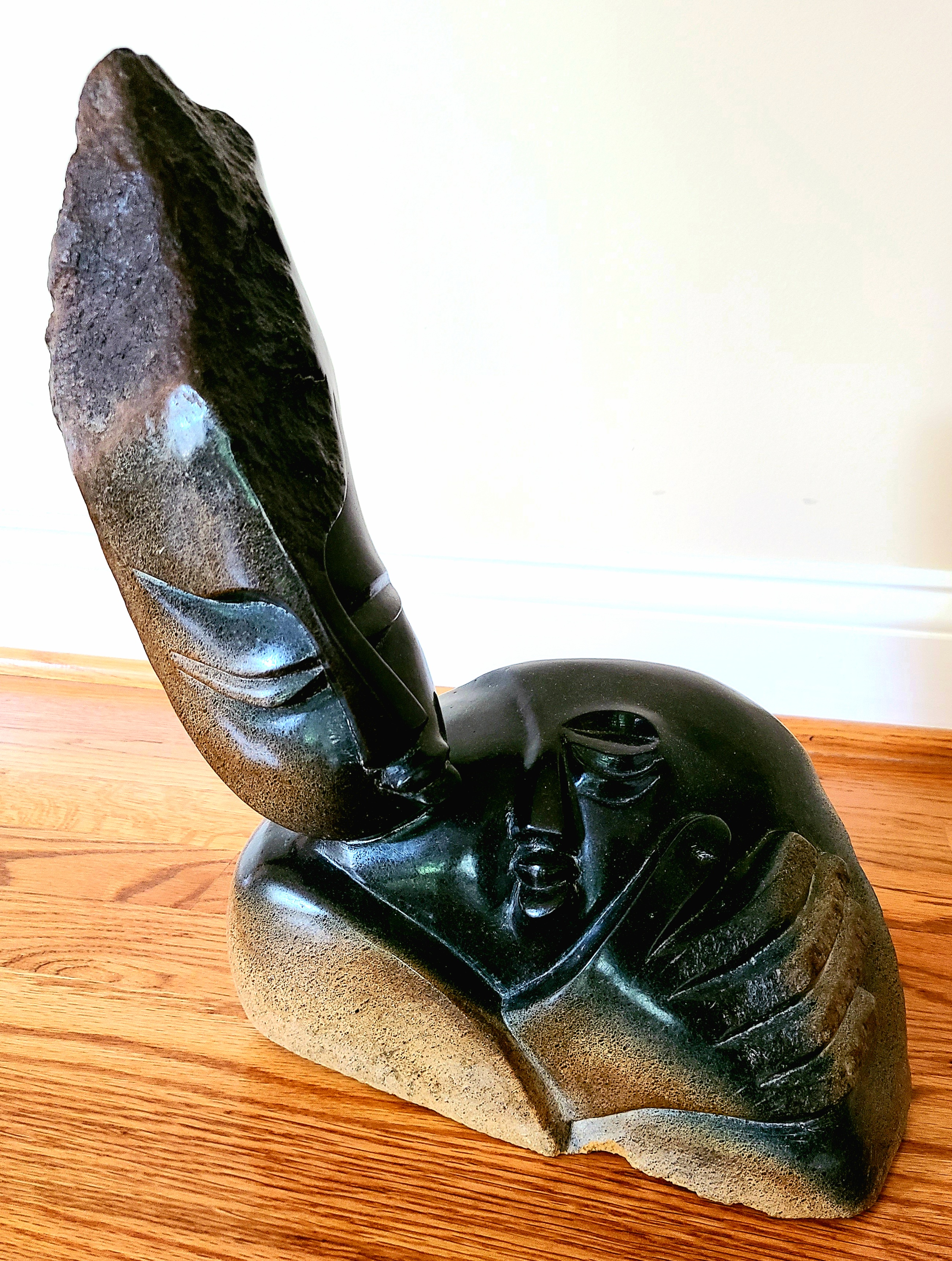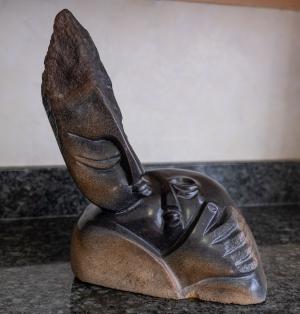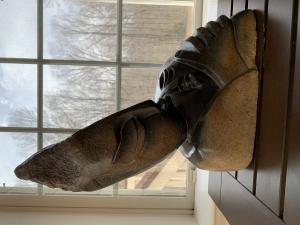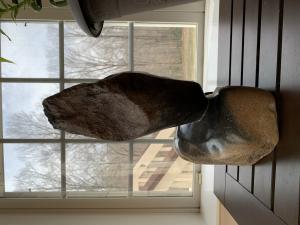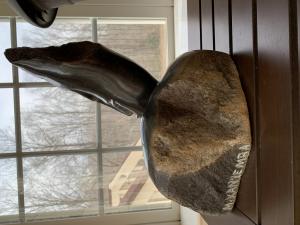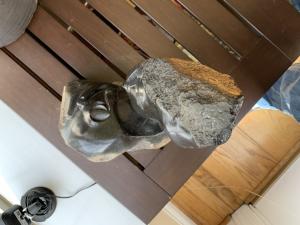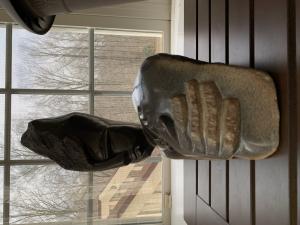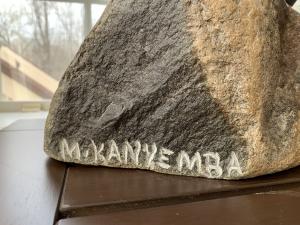Comforting Mom
Marshford Keneye
Sculpture
An abstract figure depicting a mother and child in embrace, one of the commonest themes not only in Shona sculpture, but in African art in general. They belong to the so-called “flow sculptures” (*term coined by Jonatha Zilberg in his seminal essay attached below) - highly stylized and abstract pieces that usually depict a pair, or multiples, together from a single stone, with the individual body shapes rhythmically flowing from one to the other. Beside the mother and child theme we see depicted here, flow sculpture genre includes also subjects such as dancers, happy families or general portrayals of togetherness. They have an emotional prestige value in that they are typically gifts from loved ones, many being bought for mother’s and Valentines Day and birthdays. They are even passed down as heirlooms just as are traditional objects of ritual prestige and can be seen as “religious” or “cultural” if broadly understood in terms of their framing as cultural and spiritual vehicles for Shona family values.
Because of their popularity, they are often considered to be rather mass produced kitsch, ie. the ultimate airport art. However, as art writers, scholars and local artists have argued, it is particularly Zimbabwean Shona sculptures that have exhibited a fantastic aesthetic sensibility for the material and a sense for the symbolic value of family and ‘togetherness’ - translated into the Shona tribal value “ukama”. The love of a mother towards her child is on this piece from Keneye portrayed with an incredible sense for intimacy, with the mother’s chin lightly pressed onto her child’s face while his eyes are comfortably closed, asleep, and her stone hand that perfectly embraces the child’s shape. Because of the visual nature of a flow sculpture, the wholeness of the stone is retained and the mother and child pair organically belong together. The interesting tall shape of the mother’s head probably comes from the original shape of the stone - Shona sculptors are known to just pick up interesting shaped stones, see a figure within it and carve it (hence no preliminary drawing and the origin of the myth of ‘spirits in stone’ that has permeated the marketing of Shona artworks). The top part is also interesting, the stone on one half of the top is almost uncut, the other half only polished, a delicate reminder on the materiality of the piece.
Because of their popularity, they are often considered to be rather mass produced kitsch, ie. the ultimate airport art. However, as art writers, scholars and local artists have argued, it is particularly Zimbabwean Shona sculptures that have exhibited a fantastic aesthetic sensibility for the material and a sense for the symbolic value of family and ‘togetherness’ - translated into the Shona tribal value “ukama”. The love of a mother towards her child is on this piece from Keneye portrayed with an incredible sense for intimacy, with the mother’s chin lightly pressed onto her child’s face while his eyes are comfortably closed, asleep, and her stone hand that perfectly embraces the child’s shape. Because of the visual nature of a flow sculpture, the wholeness of the stone is retained and the mother and child pair organically belong together. The interesting tall shape of the mother’s head probably comes from the original shape of the stone - Shona sculptors are known to just pick up interesting shaped stones, see a figure within it and carve it (hence no preliminary drawing and the origin of the myth of ‘spirits in stone’ that has permeated the marketing of Shona artworks). The top part is also interesting, the stone on one half of the top is almost uncut, the other half only polished, a delicate reminder on the materiality of the piece.
SHONA SCULPTURE.
Stone carving has been a part of Zimbabwean culture since the 1200s and re-emerged as a modern sculptural tradition in the 1950s, known as the “Shona movement”. The driving force behind this art renaissance was Frank McEwen, director of the Rhodesia National Gallery from 1957 to 1973. McEwen encouraged and supported aspiring artists as they started the movement that would quickly become world-renowned. International collectors and critics were amazed at the rigour, spontaneity and originality of the works coming from an area of Africa which had none of the great sculptural heritage of West Africa and had been previously described as rather barren in terms of its visual arts. Contrary to other artistic tendencies and movements coming out of Africa in the post-colonial period, Shona sculptures were not looking back at the tradition of functional sculptural objects inspired by traditional customs and rituals, rather they found their sources in the present and created sculptures that blend the contemporary moment with the memories and dreams of their tribal past - the so-called “tribal consciousness” that was thematically encouraged by McEwen, alongside more modernist expressionist tendencies. Up to today, artists, without preliminary studies, spontaneously carve out semi-abstract shapes of birds and other animal or human forms imbued with ancestral symbolism, expressing an integral part of present day Shona folklore and religious beliefs.
Stone carving has been a part of Zimbabwean culture since the 1200s and re-emerged as a modern sculptural tradition in the 1950s, known as the “Shona movement”. The driving force behind this art renaissance was Frank McEwen, director of the Rhodesia National Gallery from 1957 to 1973. McEwen encouraged and supported aspiring artists as they started the movement that would quickly become world-renowned. International collectors and critics were amazed at the rigour, spontaneity and originality of the works coming from an area of Africa which had none of the great sculptural heritage of West Africa and had been previously described as rather barren in terms of its visual arts. Contrary to other artistic tendencies and movements coming out of Africa in the post-colonial period, Shona sculptures were not looking back at the tradition of functional sculptural objects inspired by traditional customs and rituals, rather they found their sources in the present and created sculptures that blend the contemporary moment with the memories and dreams of their tribal past - the so-called “tribal consciousness” that was thematically encouraged by McEwen, alongside more modernist expressionist tendencies. Up to today, artists, without preliminary studies, spontaneously carve out semi-abstract shapes of birds and other animal or human forms imbued with ancestral symbolism, expressing an integral part of present day Shona folklore and religious beliefs.
Height: 15
Width: 10
Depth: 7
inches
Phoenix, AZ
Harare, Zimbabwe
*Material: The sculpture is carved out of springstone, a very hard member of the serpentine stone family, all of which are locally sourced in Zimbabwe. It is a beautiful dark stone, that can be polished to a high shine because of its density and presents a much bigger challenge to sculptors than other softer varieties of serpentine. As with other stones that are mined for the purpose of sculpting, springstone is mined by hand on communal lands and mostly found in northern Zimbabwe.
*Technique: These Zimbabwean sculptures are made strictly with hand, no power tools are used at any stage of the process and generally, everything is created free-form, ie. there are no preliminary sketches. The tools consist of hammers, points, chisels, rasps and chasing hammers, and the finishing of each sculpture takes almost as long as the process of creating it. The smooth effect is achieved by “washing” the sculpture, using wet and dry sandpaper and if the artist wants a high polish on the stone, the stone is heated and covered with wax (for a more detailed description of the sculpting process, see ID 48)
